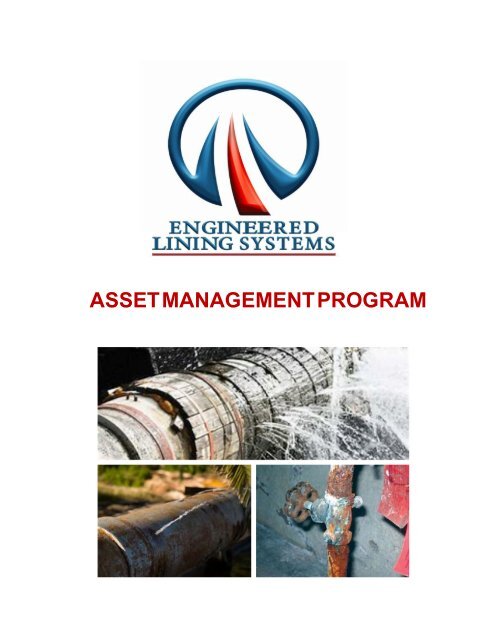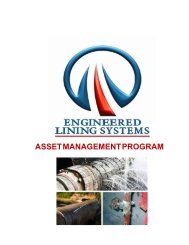Asset Management Program
- No tags were found...
You also want an ePaper? Increase the reach of your titles
YUMPU automatically turns print PDFs into web optimized ePapers that Google loves.
ASSET MANAGEMENT PROGRAM
Engineered Lining Systems <strong>Asset</strong> <strong>Management</strong> <strong>Program</strong> is recognized<br />
by property managers, owners and end users because of its proven<br />
value to your assets’ infrastructure. This program consists of two<br />
processes with specialty designed phases.<br />
ASSET MANAGEMENT PROGRAM<br />
The 1st step of the program is the Infrastructure Assessment Process,<br />
which consists of information gathering, diagnostics, planning and reporting.<br />
The 2nd step of the program is the Infrastructure Rehabilitation Process,<br />
which consists of rehabilitation of the deteriorating infrastructure.
INFRASTRUCTURE ASSESSMENT<br />
PROCESS<br />
Key Components of<br />
Infrastructure Assessment Process<br />
DISCOVERY & PLANNING<br />
PIPE CLEANING/DEBRIS REMOVAL<br />
INVESTIGATION<br />
REPORTING<br />
Working closely with the asset management team, ELS will gather information and<br />
provide a planned approach to execute the process. After information is collected<br />
and compiled into our database, we assemble reporting documents. These<br />
documents may include an array of pipe reports, infrastructure classifications with<br />
life expectancies, updated plans, GPS coordinates in Excel format and overlays<br />
on satellite views in PDF format. You will now have comprehensive information<br />
and documentation to effectively manage your infrastructure.
DISCOVERY & PLANNING<br />
Discovery<br />
The 1st step in the <strong>Asset</strong> <strong>Management</strong> <strong>Program</strong> is Discovery. Discovery<br />
is crucial because the information gathered is the basis for designing the<br />
planned approach to the overall objectives in the Infrastructure<br />
Assessment Process. The Project Manager and Superintendent will<br />
initiate Discovery by conducting a site visit and meeting with the asset<br />
management team. During this site visit, ELS will obtain any available<br />
plans, contact information and project layout.<br />
Planning<br />
ELS will provide a planned approach for approval to the asset<br />
management team. This plan will factor in schedules, flow rates, access<br />
points and hours of operation. Taking this planned approach will result in<br />
a blueprint being developed by the Project Manager and Superintendent.<br />
This blueprint will serve as an outline for the following steps in this<br />
program.
PIPE CLEANING/DEBRIS REMOVAL<br />
about other<br />
clearing methods<br />
Hydro-jetting consists of a high-pressure hose with a specialized nozzle connected to<br />
a machine that pressurizes the water. Hydro-Jetting machines produce a powerful<br />
stream that clears the infrastructure systems to provide proper access for the CCTV<br />
inspection.
INVESTIGATION (CCTV)<br />
Video cameras are one of the most essential components in the ELS toolbox for<br />
trenchless technology. ELS will meet all the CCTV pipeline inspection needs for<br />
the reporting phase, by providing high quality equipment and experienced crews.<br />
ELS utilizes waterproof, manual and remote control camera systems to analyze<br />
and report the structural condition of your infrastructure. Radio transmitters located<br />
on the camera record the depth and physical location of defects or obstructions to<br />
accurately diagnose your assets. Some identifiable problem areas would be<br />
grease buildup, root intrusion, misalignment, pinhole leaks, broken and corroded<br />
piping systems. In addition, the inspection will identify branch lines locations.<br />
Branch lines will need to be classified as active or inactive. CCTV equipment will<br />
produce engineered quality reports that will be provided with deliverables. The<br />
images and video will be saved for your permanent records and used during the<br />
reporting phase. The reports helps you understand and manage your assets for<br />
piping systems from 2” to 72”.
GEOGRAPHIC INFO SYSTEM<br />
The Geographic Information System (GIS) is designed to capture, store,<br />
manipulate, analyze, manage and present all types of geographical data.<br />
REPORTING<br />
Reporting is the final phase of the Infrastructure Assessment Process. ELS will<br />
provide all CCTV Reports, Updated Plans, Satellite Images with GIS overlay<br />
(PDF), GPS coordinates (Excel) and Classifications of infrastructure with<br />
remaining life span as required by contract. All deliverables and essential<br />
information can be used for planning, budgeting, management of your asset and<br />
forecasting failures in your infrastructure. ELS can now apply the second process<br />
of this program to prevent these failures from happening.
SAMPLE OF REMAINING USEFUL<br />
LIFE CHART<br />
Line Size Sanitary A B C<br />
3" to 6" 0 0 0 0<br />
8" to 10" 3634 1428 881 1325<br />
Totals 3634 1428 881 1325<br />
Line Size<br />
Storm<br />
3" to 6" 0 0 0 0<br />
8" to 10" 107 0 107 0<br />
12" to 16" 372 0 69 303<br />
18" to 24" 2971 504 796 1671<br />
25" to 30" 1767 593 986 188<br />
32" to 36" 933 0 17 916<br />
38" to 42" 0 0 0 0<br />
46" to 52" 43 43 0 0<br />
54" to 60" 1320 353 697 270<br />
66" to 72" 1659 104 1555 0<br />
75" to 86" 0 0 0 0<br />
Totals 9172 1597 4227 3348<br />
Sanitary 3634<br />
Storm 9172<br />
Total 12806<br />
.<br />
A<br />
B<br />
C<br />
Like New Condition<br />
Some Minor Defects, Reevaluation in 3 to 5 Years<br />
Major Defects and Immediate Repairs are Recommended
INFRASTRUCTURE REHABILITATION<br />
PROCESS<br />
The 2 nd step of the program is the Infrastructure Rehabilitation Process. This<br />
process consists of planning and executing the rehabilitation of the deteriorating<br />
infrastructure. Engineered Lining Systems provides several options when<br />
rehabilitating infrastructure. The process and material can change depending on<br />
the application, type of drainage system and access to the infrastructure in<br />
question. The rehabilitation method will be determined during the planning<br />
phase of this process.
PLANNING<br />
The reporting from the <strong>Asset</strong> Assessment Process is the blueprint for planning the<br />
rehabilitation. ELS will have a Project Manager and Superintendent working together<br />
during the planning phase. The planning phase of the interior and exterior<br />
rehabilitation will have different schedules, logistics, materials and level of<br />
coordination. ELS will use its network of worldwide suppliers and engineers to provide<br />
the solution to extend the life of the asset 50 to 70 years.<br />
Planning the interior infrastructure involves specific challenges with flow rates,<br />
bypassing, access to tenant space, working hours and material cure times. These<br />
challenges will be overcome by using specialty trained technicians, an on-site<br />
superintendent, and a project manager from headquarters.<br />
Planning the exterior phase involves similar challenges to interior but not identical.<br />
Maintenance of traffic, bypassing, parking spaces, working hours, equipment staging<br />
and material cure times. Engineering is taken to a different level due to the increase in<br />
pipe diameter and ground water levels. These challenges will be overcome by using<br />
licensed engineers, trained technicians, on site superintendant and a project manager<br />
from headquarters.
INFRASTRUCTURE REMEDIES<br />
CURED IN PLACE PIPE (CIPP) REMEDY<br />
A fiberglass or felt sleeve is impregnated with resin and is inflated with air or water. After<br />
the liner is inserted into the pipe. The resin is hardened by Ultraviolet light or Thermal<br />
setting with heat and steam. Ultra-Violet Cured in Place Pipe (UV CIPP) not only is the<br />
most environmentally sound trenchless technology on the market today but also has the<br />
highest production value, allowing multiple pipe runs to be rehabilitated over the course of<br />
an 8 to 10-hour day.
EPOXY COATING REMEDY<br />
Epoxy coating is also an excellent option for interior infrastructure rehabilitation.<br />
The epoxy method is applied by spin casting or brushing, P-traps and turns<br />
in the piping system are restored to optimal condition with this method.<br />
.
CONSTRUCTION BUILD BACK<br />
If any alterations to the interior or exterior of the property is required such as<br />
wall removal, digging of pit or trench, ELS will restore as close to previous<br />
condition as possible. While work is being performed ELS will temporarily<br />
close these areas off to minimize impact to owners or customers.<br />
REPORTING<br />
Once, the rehabilitation phase is complete, ELS will collect and enter all<br />
updated information into our database, ELS will then update the asset<br />
documents. These assets documents may include an array of pipe reports,<br />
classification with life expectancies, updated plans, GPS coordinates in excel<br />
format and overlays on satellite views in PDF format. You will now have the<br />
proper information and documentation to manage your assets.
Engineered Lining Systems works with clients nationally and internationally to<br />
successfully rehabilitate and restore piping and structures for commercial,<br />
governmental, industrial, educational and military facilities using our cutting-edge and<br />
environmentally sound trenchless technology. We appreciate your time and would<br />
love the opportunity to discuss with you and your company further how ELS can<br />
better serve your infrastructure needs.<br />
888-384-9549<br />
EngineeredLining.com
















